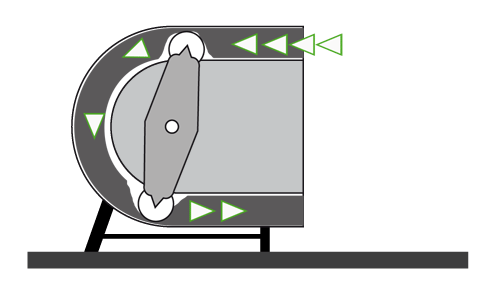How does a Peristaltic Pump Work?
Working of a Peristaltic Pump
The main components of a peristaltic pump are:
- the peristaltic hose
- the rotor equipped with its rollers.
The rotor, in its rotating move, applies a pressure to the peristaltic hose through the two rollers (some pumps do have 3).
Downstream of each roller – pressure side – the fluid is pushed by the roller’s move.
Upstream or suction side – the move creates a depression which sucks fluid from the tank in which it is stored.
The downstream pressure created by the rotor’s revolution, is in the order of 5 to 6 bars. It can go up to 10 bar.
The pressure applied by the rollers on the peristaltic hose is such that it is almost perfectly crushed and thereby forms a waterproof barrier which by its moving, creates a depression on the suction side. The vacuum or depression created on the suction side is about 0.6 to 0.8 bar.
Benefits of LSM Pumps
- The vacuum created in the suction side is such that the pump is self-priming.
- The suction is such that it allows fluids to be lift up by 3 to 4 m below the level of the pump, up to 8 m with an optional vacuum pump applied on the pump body.
- The LSM peristaltic pump runs in 2 directions. This is particularly beneficial when automated processes, including PLC’s and sets of valves direct the fluid from and to various tanks, all this with just one pump.
- The peristaltic pump is volumetric. At a defined rotation speed, the flow rate is delivered with an accuracy of around 1%. This feature offers great flexibility of use in automated processes.
- The pressure applied by the rollers on the hose, seals suction and pressure sides off. As a result, in case the LSM pump stops, there is no flow backward possible.
- The only part of the entire pump to be in contact with the fluid is the peristaltic hose. Nothing else – no mechanical seals or all sorts of O-Rings. This is a big benefit, meaning that contamination with fluid is quasi impossible. And the cleaning process is much safer and quicker.
- The diameter of the peristaltic hose allows a large free passage, which makes the LSM pump well adapted when the fluid solid content is high. It tolerates bodies such as sand, pebble, etc.
As an example, it is frequently used to unload fishing boats from their fish cargo or as transfer from aquaculture ponds to dock, etc. - LSM Pumps are particularly suited for highly viscous fluids or heavily loaded with solid content.
- The LSM Pump hose is continuously lubricated. This lowers drastically both the wearing of the hose as the energy consumption.
- The LSM pump tolerates Dry Runs for a limited time – extremely rare feature of the pump world.


